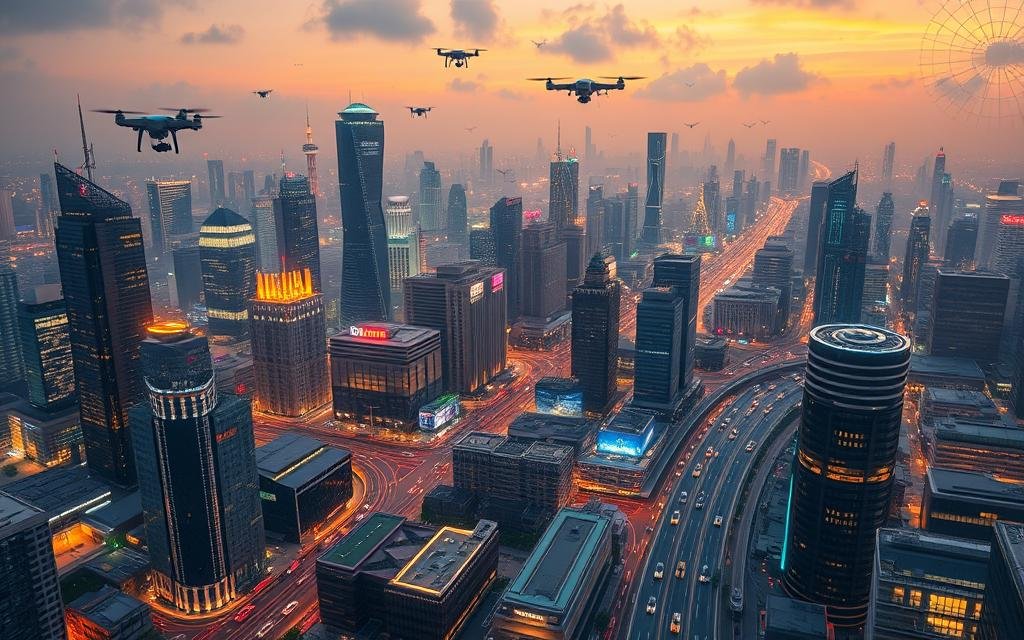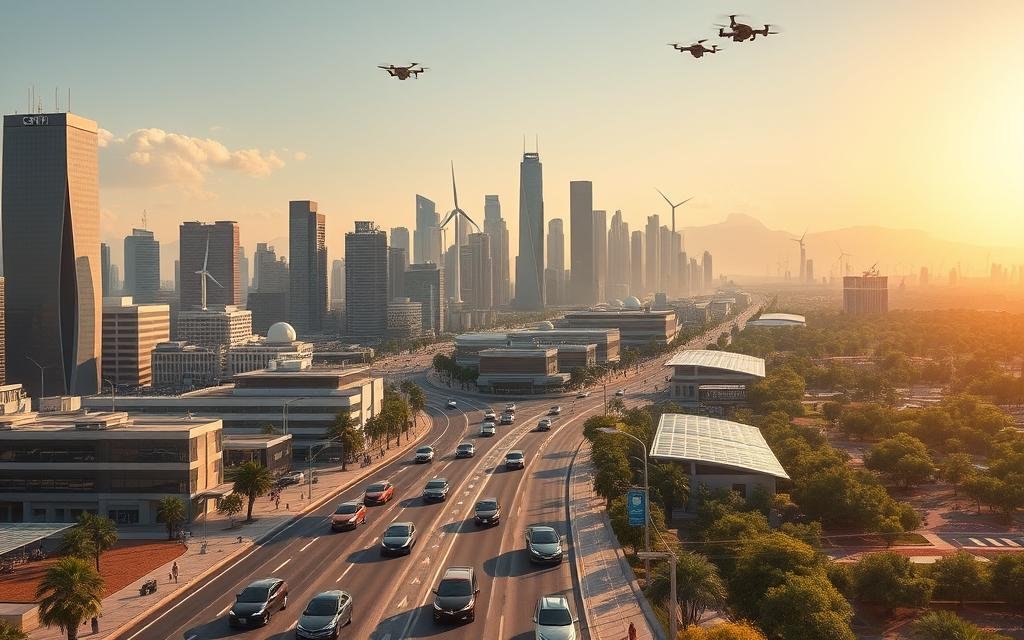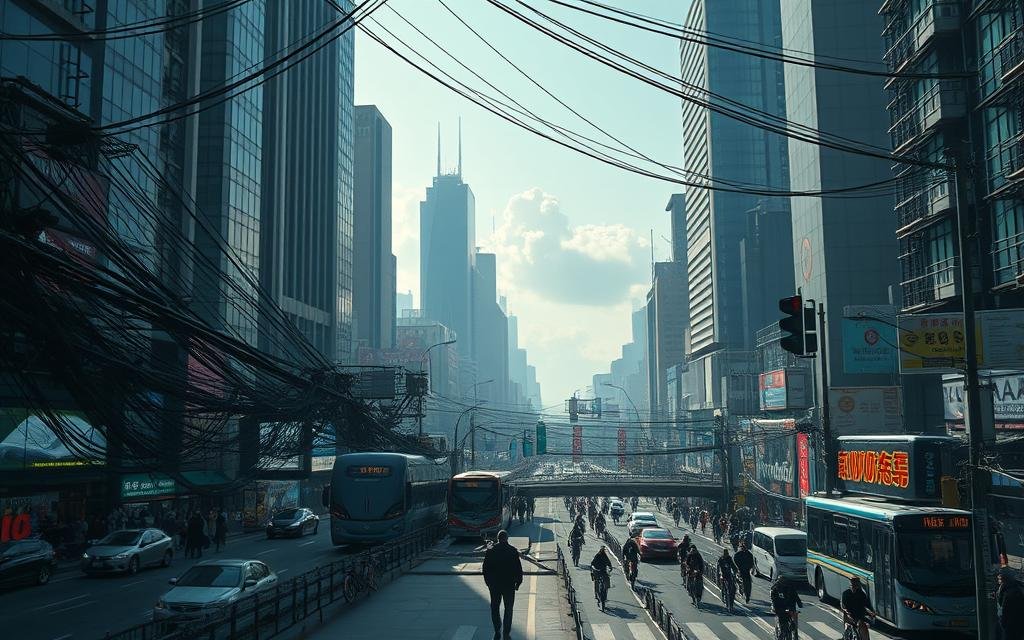By 2050, nearly 7 out of 10 people will call urban areas home, according to UN projections. This rapid growth demands innovative solutions to keep communities efficient, sustainable, and livable. Today’s metro hubs are evolving with cutting-edge tech to meet these challenges head-on.
From real-time traffic sensors to AI-powered energy grids, modern infrastructure blends connectivity with data-driven decision-making. The U.S. Department of Transportation highlights three critical components: sensor networks, seamless connectivity, and transparent data sharing. These pillars transform how residents interact with their environment.
Take Singapore as an example—its 98% public WiFi coverage sets a global benchmark. Similar advancements elsewhere reduce emissions by 20-35% while creating thousands of tech jobs. The focus remains clear: enhancing quality of life through resident-centered design.
Key Takeaways
- Over half the world’s population currently lives in urban zones
- IoT and AI optimize transportation, energy, and infrastructure
- Open data systems empower citizens and governments alike
- Tech-driven solutions significantly lower carbon footprints
- Autonomous vehicles and predictive maintenance redefine urban mobility
What Are Smart Cities?
Decades of innovation have reshaped how communities function, leveraging data and connectivity. Today’s urban hubs are no longer just physical spaces—they’re dynamic ecosystems where technology optimizes everything from traffic flow to energy use.
Defining the Smart City Concept
The National Institute of Standards and Technology (NIST) frames these hubs as interconnected systems. Data capture, analysis, and real-time sharing form the backbone of operations. Modern infrastructure integrates IoT sensors, AI, and open-data platforms to improve efficiency.
Los Angeles pioneered this approach in the 1960s with poverty mapping. Now, real-time systems like Chattanooga’s air quality monitors show how far we’ve come. It’s not just about technology—it’s about people. McKinsey notes:
Citizen engagement is now central to smart ecosystems.
The Evolution of Smart Cities
The term emerged in 1990s academic papers, but the shift from government-led projects to collaborative models is key. Vienna’s Smart City 3.0 plan lets residents invest in solar panels, while Barcelona’s buses double as WiFi hotspots.
Global initiatives reflect this growth:
- Dubai aims for 25% autonomous transport by 2030
- The market will hit $1.1 trillion by 2028 (Statista)
These milestones prove tech’s role in building resilient, responsive communities.
Key Technologies Powering Smart Cities
Behind every efficient urban hub lies a network of interconnected tech. These tools tackle congestion, pollution, and energy waste while improving daily life. Here’s how they work.
Internet of Things (IoT) and Sensors
IoT networks rely on *sensors* to collect real-time data. San Diego’s 3,200 *sensors* optimize parking and traffic flow, reducing delays by 15%. By 2025, IoT Analytics predicts 41.6 billion connected devices globally.

Kansas City’s 50-block free WiFi and smart streetlights show IoT’s scalability. These *systems* cut energy use by 30% while enhancing public safety.
Artificial Intelligence and Machine Learning
AI processes vast data streams to predict needs. Barcelona’s waste trucks use AI to plan routes, slashing fuel use by 35%. Dubai’s AI-powered emergency response is 30% faster.
Smart Transportation Systems
Traffic lights now adjust in real time using congestion data. Orlando’s CS3 project tests vehicle-to-infrastructure communication, easing bottlenecks. *Autonomous vehicles* further reduce accidents and emissions.
Energy-Efficient Infrastructure
Madrid’s solar-powered EV stations and Singapore’s predictive pipe maintenance save resources. Smart grids could save $130 billion yearly (WEF).
| Initiative | Location | Impact |
|---|---|---|
| Link5G kiosks | New York City | Free WiFi + emergency calls |
| Lamppost EV chargers | London | 10,000 charging points by 2025 |
These *technologies* prove that smarter *systems* are key to sustainable growth. The future is built on data-driven decisions.
Benefits of Smart Cities
Urban innovation isn’t just about flashy tech—it delivers measurable improvements where they matter most. From healthcare to job markets, data-driven solutions enhance daily life while protecting resources.
Enhanced Quality of Life for Residents
Safer streets, faster healthcare, and inclusive design define modern urban living. Seoul’s AI-powered emergency teams reach patients in under 4 minutes. London’s Ultra Low Emission Zone (ULEZ) cut toxic air pollution by 44% since 2019.
Tokyo’s AI navigation guides visually impaired residents, while ShotSpotter technology reduces gun violence by 35% in pilot areas. *It’s not just convenience—it’s dignity.*
Improved Sustainability and Environmental Impact
Prioritizing sustainability, Barcelona’s smart water systems save 58 million cubic meters annually. Smart meters slash household energy use by 5–15%, per the U.S. DOE.
Renewable projects like Madrid’s solar-powered EV stations prove efficiency and eco-friendliness go hand in hand. The planet wins when tech meets thoughtful design.
Economic Growth and Job Creation
Every $1 invested in solutions like smart grids yields $5 in return, reports Brookings. Columbus, OH, sparked 2,800 new businesses through innovation grants.
By 2025, the U.S. could see 500,000+ tech jobs in this sector. Dubai’s blockchain visas show how economic growth pairs with seamless tourism experiences.
- Health: Faster ambulances, cleaner air
- Planet: Lower emissions, smarter water use
- Wallet: New jobs, energy savings
Smart City Initiatives in the United States
American urban centers are leading the charge in tech-driven transformation. From free public WiFi to AI-powered traffic management, these programs prove innovation thrives on home soil. Here’s how major metros are setting benchmarks.

New York City’s Smart Solutions
New York’s LinkNYC kiosks deliver gigabit WiFi to 2,000 locations, replacing payphones with digital hubs. Midtown congestion pricing slashed traffic by 15%, while smart streetlights save $1M yearly in energy costs.
It’s not just tech—it’s impact. Real-time flood sensors in Miami now give 6-hour warnings, protecting coastal neighborhoods.
Los Angeles’ Traffic and Air Quality Programs
Los Angeles tackles gridlock with ATLAS, syncing 4,500 traffic signals. Metro Micro shuttles cut first-mile emissions by 40%, and air quality monitors track pollution hotspots.
“Data transforms how we move,” notes LA’s transport chief. Predictive policing in Kansas City further shows how smart city initiatives enhance safety, reducing crime by 30%.
Emerging Smart Cities: Kansas City and Columbus
Columbus leveraged a $50M DOT grant to optimize freight corridors, trimming delivery times by 20%. Kansas City’s predictive tools streamline everything from parking to policing.
Austin’s Community Solar project powers 10,000 homes, proving scalable infrastructure works. As these hubs grow, they redefine what’s possible for urban living nationwide.
Challenges and Concerns
While tech-driven urban solutions promise efficiency, real-world implementation faces significant hurdles. From cybersecurity gaps to cultural resistance, these challenges require thoughtful solutions. Let’s examine the key barriers slowing progress.

Data Privacy and Security Risks
Connected systems collect vast amounts of personal data—often without adequate protection. A Ponemon Institute study reveals 73% of municipalities lack cybersecurity training programs.
Atlanta’s 2018 ransomware attack cost taxpayers $17 million in recovery. London’s facial recognition trials produced 96% false positives, raising ethical questions. As one expert notes:
“Without trust, no amount of innovation will gain public acceptance.”
Infrastructure and Connectivity Issues
40% of Detroit households lack home broadband, creating a digital divide. San Francisco’s $1.6 million “smart” trash cans failed due to maintenance challenges.
Reliable connectivity remains uneven nationwide. Outdated power grids and water infrastructure complicate tech integration in older neighborhoods.
Balancing Technology with Cultural Authenticity
Paris restricts Airbnb rentals to preserve local housing markets. San Jose residents protested $20,000-per-unit smart streetlights, citing cost concerns.
Progress must respect community identity. Toronto’s Sidewalk Labs project collapsed after people rejected its data collection policies.
| Challenge | Example | Solution Trend |
|---|---|---|
| Privacy risk | Facial recognition errors | Opt-in data policies |
| Connectivity gaps | Detroit broadband deserts | Public-private partnerships |
| Business costs | San Jose streetlights | Phased rollouts |
These hurdles remind us that technology works best when it serves people, not the other way around. Addressing them head-on ensures equitable progress for all residents.
Global Examples of Smart Cities
Five continents now host pioneering examples of tech-enhanced community living. These hubs blend technology with urban design to create cleaner, safer, and more efficient spaces. Let’s explore three leaders setting benchmarks for the future.
Singapore’s Digital Ecosystem
The island nation leads with its Virtual Singapore 3D model. This digital twin helps planners simulate floods and optimize building placement. Over 1 million IoT sensors monitor everything from trash levels to foot traffic.
Residents enjoy 98% digital government services—no queues for permits or payments. It’s efficiency at scale, says urban minister Desmond Lee. The system even predicts maintenance needs before pipes burst.
Barcelona’s Citizen-Centric Approach
Spain’s second-largest city reclaimed 60% of street space through “superblocks.” These car-free zones prioritize pedestrians and cyclists. The Decidim platform lets citizens vote on budget allocations directly.
Integrated sensors manage irrigation for 1,400 parks, saving enough water for 60,000 residents annually. Waste trucks follow AI-optimized routes, cutting fuel use by one-third.
Dubai’s Visionary Projects
This desert metropolis now 3D prints buildings, reducing construction waste by 60%. Its blockchain land registry saved 77 million work hours previously spent on paperwork.
By 2030, 25% of transport will be autonomous. Projects like solar-powered bus stops show how ambition meets execution. “We build the impossible,” says AI minister Omar Al Olama.
| Initiative | Location | Key Metric |
|---|---|---|
| Carbon-neutral grids | Copenhagen | 100% renewable by 2025 |
| Earthquake alerts | Tokyo | 60-second warning system |
| Geothermal energy | Reykjavik | 100% clean power for 230K people |
From Amsterdam’s circular economy to Boston’s smart city labs, the world proves tech-driven solutions work at scale. These models offer blueprints for any urban area seeking transformation.
Conclusion
Your city’s future hinges on balancing progress with people-first values. By 2025, global investments will surpass $800B, but true success lies in serving residents, not just deploying flashy tools. AI urban planners may become standard by 2030, yet without ethical guardrails, these systems risk widening inequities.
U.S. metros like Orlando are proving technology thrives when paired with democratic input. Their 2040 plan merges tourism with eco-friendly transit, showing how vision meets practicality. Meanwhile, standardized cybersecurity frameworks remain urgent to protect sensitive data.
The takeaway? Prioritize sustainability and inclusivity over profit-driven real estate plays. When communities lead the charge, innovation follows—naturally and equitably.
FAQ
What defines a smart city?
A smart city uses advanced technologies like IoT, AI, and sensors to enhance urban living. These innovations improve efficiency in transportation, energy, and public services.
How do smart cities improve sustainability?
They reduce emissions through energy-efficient buildings, optimized traffic systems, and renewable energy sources. This leads to cleaner air and lower carbon footprints.
What role does AI play in smart cities?
AI analyzes data from sensors to optimize traffic flow, predict maintenance needs, and enhance public safety. It helps cities run more smoothly and respond faster to issues.
Which U.S. cities lead in smart initiatives?
New York and Los Angeles are pioneers, with programs for traffic management and air quality. Emerging hubs like Kansas City and Columbus also implement smart solutions.
Are there privacy risks with smart city tech?
Yes. Data collection through sensors and cameras raises concerns. Cities must balance innovation with strong cybersecurity and transparent policies.
How do smart transportation systems work?
They use real-time data to manage traffic lights, parking, and autonomous vehicles. This reduces congestion and improves commute times.
What global cities are leading in smart tech?
Singapore excels with its integrated systems, while Barcelona uses IoT for utilities. Dubai invests in ambitious projects like AI-powered government services.
Can smart cities boost local economies?
Absolutely. They attract tech investments, create jobs in innovation sectors, and improve business efficiency through better infrastructure.
